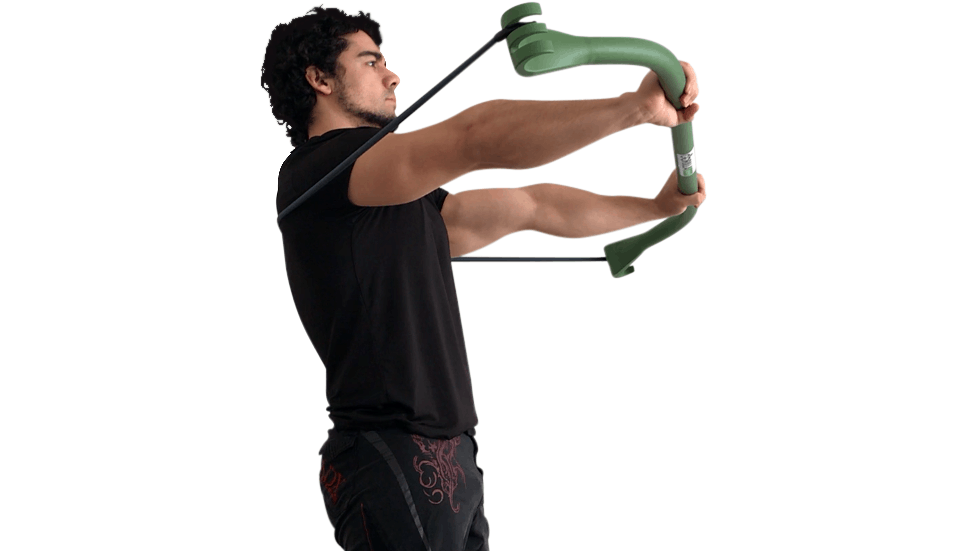
Resistance bands can be part of an exercise routine for a variety of reasons. They serve many different functions and are one of the most inexpensive pieces of fitness equipment you could buy. Some people use them for mobility and stretching, which others use them as part of a resistance training program.
Public interest in resistance band training has risen as more people do their workouts in-home (for one reason or another). In turn, this has led people to question the muscle building potential of training solely with bands.
Resistance bands create mechanical tension on the muscle just like free weights, thus they are an effective way to build muscle. As the user gets advanced, however, it will become more difficult to add muscle due to the limitations of training with resistance bands alone.
When force is applied to muscle, mechanical tension is created. Over time the body adapts to this tension and grows new muscle. This is a scientific way of saying if you work out hard, consistently, with proper form; you are bound to build muscle no matter what exercise modality you use.
It is true that a person who trains only with resistance bands would be missing out on maximizing muscle growth. But the same could be said for someone only training with dumbbells, or machines, or bodyweight. A well-structured plan using a variety of equipment is the best way to maximize muscle gains.
But the idea that you can’t build a considerable amount of muscle with resistance bands is simply not true. Many professional athletes develop muscular physiques with the bulk of their strength and conditioning work revolving around band training.
Can You Bulk Up With Resistance Bands?
Resistance bands will fall short for anyone looking to pack on muscle mass in two different ways; exercise limitations and lack of progressive overload.
You can do quite a bit with resistance bands, but not as much as free weights. Resistance bands are most effective in building biceps and shoulder muscles. You can perform bicep curls, hammer curls, lateral raises, front shoulder raises, upright rows, and even shoulder presses with bands.
Chest, back, and leg development will be much more difficult. Unfortunately these are major muscle groups, and play a big role in the overall appearance of one’s physique.
Chest exercises are limited to floor presses and pushup variations with the band across your back. This just isn’t enough to make significant progress. Back exercises are limited to bent over rows, or standing rows if you’re able to loop the band around a pole. For legs you could squat or perform a Romanian deadlift.
Bands make progressive overload a challenge as well. With dumbbells or barbells you could simply increase the weight to overload muscles after a certain weight becomes too easy. The nature of resistance bands makes this more difficult.
As the band gets stretched, the exercise becomes more challenging. For example, a bicep curl gets harder as you contract because the band is stretched more and more. A dumbbell does not work like this; the weight is the same throughout the entire motion.
This unique aspect of resistance bands actually becomes a limiting factor. When a given resistance becomes too easy, the natural progression is to move on to a thicker band with more resistance. However, what often happens is the user gets “stuck” in the middle of an exercise and cannot complete the full range of motion. You can start the motion with the thicker band, but you can’t finish it.
The solution is usually just to perform more reps with the same resistance. This works to a certain degree, but at a certain point a greater force needs to be applied to the muscle in order for it to grow.
One way to circumvent this is to invest in something like the Gorilla Bow. The Gorilla Bow is an odd looking piece of exercise equipment, but is actually quite functional. It’s basically a long metal bar with multiple slots on the end to attach bands.

The bar allows for greater exercise variety and the multiple slots allow you to attach two thin bands as opposed to one thick band. The smaller bands let you increase the resistance, but not to the extent of limiting range of motion (like one thick band would potentially do).
You could also use TRX bands, which can be hung in any room with a door. They are easy to carry around and can be used in parks as well. TRX bands use your own body weight to apply force. The positioning of your body determines the difficulty of the exercise. In most cases, the more parallel you are to the ground, the harder the movement.
How to Add Resistance Bands to a Routine
Some people may have access to a gym and already take part in a workout routine with free weights, cables, and machines. They may wonder if there is any added benefit to implementing work with resistance bands.
In this situation, resistance bands take on a different light. Earlier we mentioned the importance of variety, or cross training, within a routine. For someone already using a gym, resistance bands add novelty to the workout program.
Novelty in training is important, especially as you get more advanced. It becomes more challenging to stimulate the muscles in a way that elicits growth when you’ve been working out for many years. At this stage, an intermediate or advanced lifter would benefit greatly from adding bands.
With full access to a gym, you could incorporate resistance bands with established compound exercises. For example, you may have seen people attach bands to each end of a barbell when performing squats or bench presses.

The addition of bands, coupled with the exercise itself, adds a novel resistance. We know that bands are unique in that the resistance is increased as the band is stretched. You could conceivably add resistance bands to any barbell exercise, and it would change completely.
When you perform a traditional barbell squat, the force remains the same throughout the entire motion. However, when you add bands, the force increases as you extend your legs back to the standing position (because this is when the band becomes stretched).
Summary
Muscle growth occurs when mechanical force is applied consistently over a long period of time. Most people associate this force with resistance exercise using barbells, dumbbells, cables, or machines. However, resistance bands are capable of applying this tension as well.
Given the limitations of how the resistance bands can stretch and move, they are more appropriate for building certain muscles compared to others. But with some creativity, you can structure a full body training program using resistance bands.
While resistance bands may lack in some aspects compared to free weights, they also do things that free weights can’t do. They increase in tension as the band is stretched. The elasticity also makes them safer to use. Free weights work against gravity, and could put the user at risk if not used properly. The bands will always return back to their normal position.
The ideal situation would be to use bands in conjunction with all of the equipment found in a typical gym. Variety is important when trying to build muscle.
Recent Posts
Stretching Before Workouts: Essential Warmup or Performance Killer
“Don’t stretch before workouts, your muscles become too supple” “Stretch before your workouts, warming up is important” It's conflicting advice like this that drives people crazy,...
Best Protein Bar For the Money | Cost Effective, High Quality
Protein bars are no longer a supplement dedicated to diehard gym rats, with awful taste and the consistency of a brick. Men, women, and even teenagers can commonly be seen eating protein bars. The...
